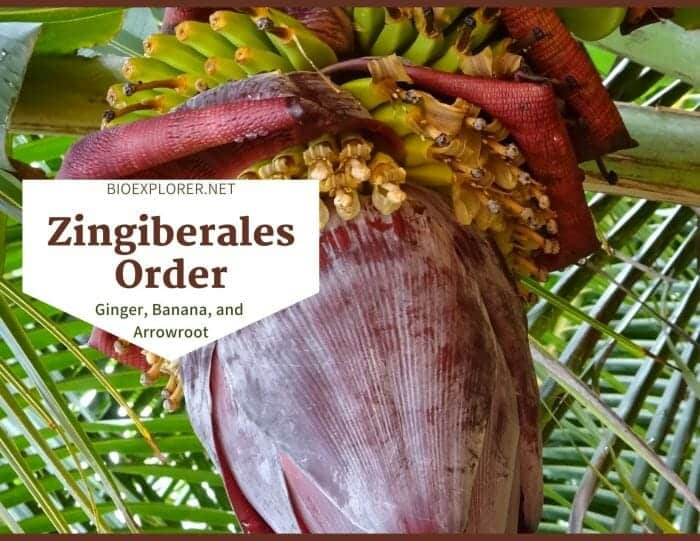
Zingiberales’ order comprises several species of great economic importance, like the banana and the ginger. Members have almost restricted distribution to tropical regions. Zingiberales species have ptyxis, large flowers, attractive colors, and inferior ovaries. Pollination of Zingiberales involves a diverse group of pollinators (insects, birds, and fruit bats).
Table of Contents
Zingiberales Families
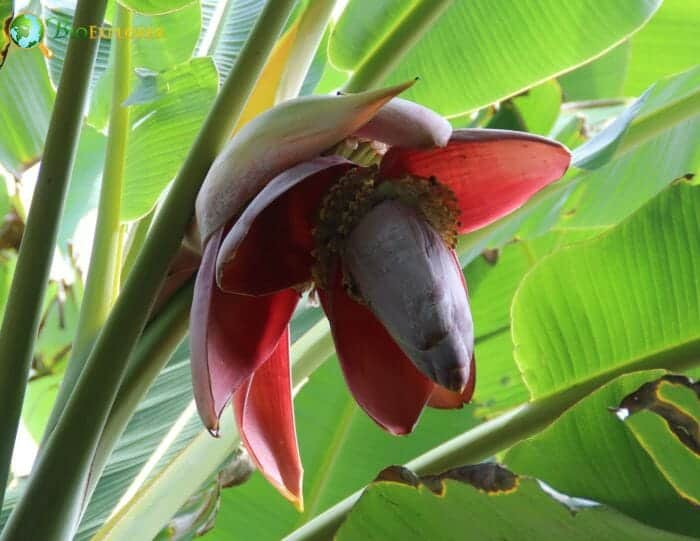
Zingiberales has a well-defined, monophyletic group of 8 families, 92 genera, and more than 2100 species. The eight families under Zingiberales are:
- Musaceae (Banana family)
- Strelitziaceae (Bird-of-paradise flower family).
- Lowiaceae (Orchidantha inoue, Orchidantha maxillarioides, Orchidantha chinensis & a few more).
- Heliconiaceae (Platanillio family)
- Zingiberaceae (Ginger family)
- Costaceae (Costus family)
- Cannaceae (Canna Lily family).
- Marantaceae (Arrowroot family)
![]()
Zingiberales Distribution
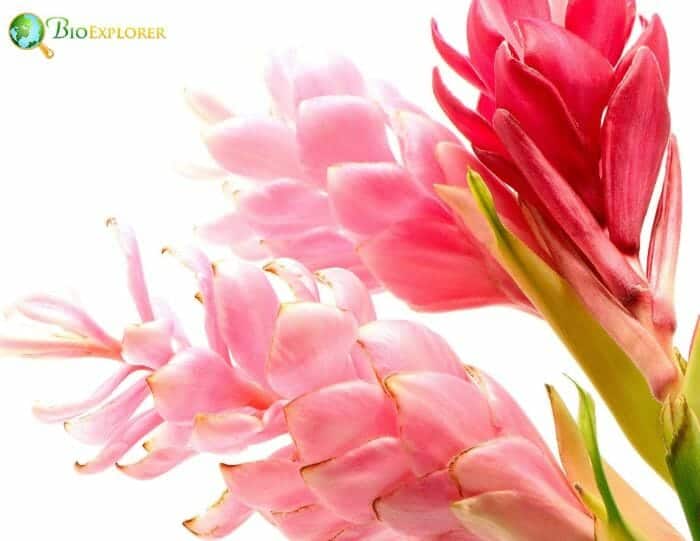
The members under Zingiberales have almost restricted distribution to tropical regions. They occur primarily in wet lowlands or understory flora of wet tropical regions of Asia, Africa, and the Americas.
- The order’s most prominent family, Zingiberaceae (ginger family), comprises 53 genera and over 1, 300 species[1]. This family is broadly distributed all over the tropics and subtropics. However, the species are incredibly abundant in Southeast Asia.
- The families of Heliconiaceae, Marantaceae (arrowroot family), and Costaceae are mostly Neotropical. Musaceae, the banana family (2 genera and 40 species), is native to Africa, Asia, and Australia.
- Strelitziaceae (3 genera and 7 species[2] ) are tropical and subtropical. They are found in Madagascar, the Northeast of South America, and the Southeast of the African continent.
- Lowiaceae (1 genus and 10-20 species)[3] are found in tropical China, Vietnam, Laos, Thailand, Malesia, West Malaysia, and Borneo.
- The Cannaceae (1 genus and 10 species)[4] are scattered from the southeastern part of Noth America through South America.
![]()
Zingiberales Characteristics
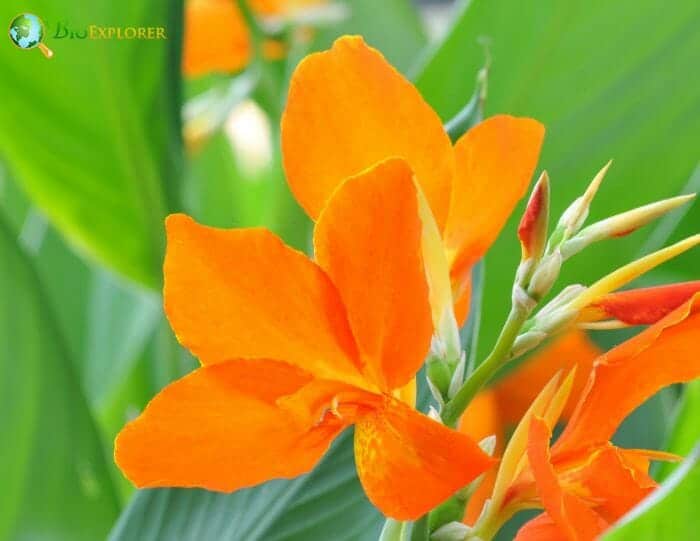
- Plant type: Zingiberals are usually large herbs and rarely trees. Members of this order or monocotsWhat is monocots?Angiosperm having only one cotyledon. Cotyledon is seed leaf; the first leaf (or set of leaves) to appear during the early development of a seedling.. They possess only one seed leaf.
- Stem: The diaphragm air chambers and silica cells are present in the leaves and stems of the Zingiberales members. Members are herbaceous plants with rhizomes. Therefore, they only acquire an aerial stem when flowering.
- Leaves: The leaves have penniparallel venation. All Zingiberales members have ptyxis. This is the disposition of a single leaf in the bud. One half of the blade is rolled entirely within the other along the longitudinal axis (supervolute).
- Flowers and inflorescences: Most flowers are large and have attractive colors. Inflorescences are generally racemose with noticeable bracts.
- Sepals and petals: The calyxWhat is calyx?A collective term for all the sepals of a flower; the lowermost whorl of floral orgrans (Plural form is calyces). and corollaWhat is corolla?A collective term referring to the petals of a flower. are separated in the perianth. The flowers have 3 sepals and 3 petals.
- Stamens and carpels: Zingiberales have up to 6 stamens in 2 whorls. The carpels are 3.
- Ovary and fruit: All species of Zingiberales have an inferior ovary. The fruit is usually a capsule. Some species have berry or drupe.
- Seeds: The seeds are aril.
![]()
Zingiberales Flowers and Reproduction
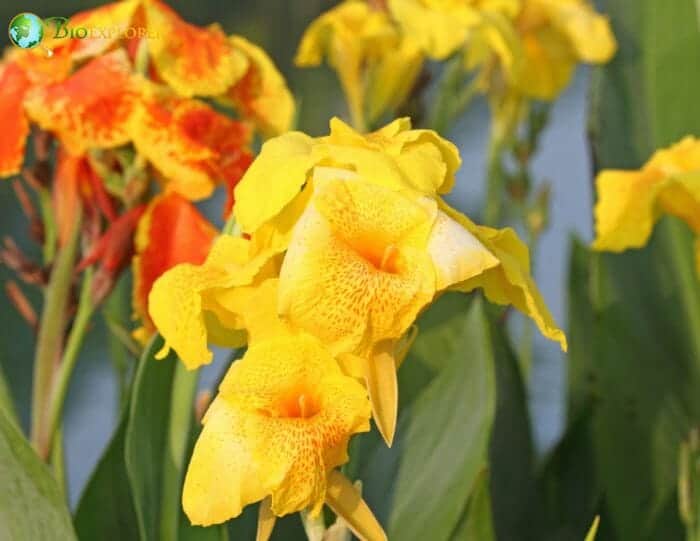
The flowers of Zingiberaceae are brightly colored with nectars in the flower tubes. The presence of the 2 or 3 fused stamens or labellum combined with the pair of petal-like stamens makes the flowers look like an orchid.
- The flowers can be solitary or in spike, raceme, or thyrse inflorescences. They are bracteates, epigynous, bisexual, and zygomorphicWhat is zygomorphic?A characteristic of the flower having only one plane of symmetry, as in a pea or snapdragon; bilaterally symmetrical; especially about a flower or corolla; Opposite is Actinomorphic; irregular flower;. The perianth has two whorls, the calyx, and the 3-lobed petaloid tubular corolla.
- The androecium is made up of 1 stamen (fertile). There are four petaloid staminodes, the 2-form anterior labellum in the inner whorl connate and the other 2 in the outer whorl. The ovary is inferior, and the fruit is capsule or berrylike.
- Musaceae flowers[5] are medium-sized to large and are very irregular. The inflorescence is a terminal thyrse of few-flowered cymes. Flowers are bracteateWhat is bracteate?Possessing or bearing bracts., zygomorphic, and functionally unisexual. There are 2 series of 6 petaloid tepals in the flower’s perianth. There are 5 fertile stamens and a staminode in the androecium. The gynoecium comprises 3 carpels in a single pistil, 1 style, and an inferior ovary. The fruit is a berry with many seeds.
- Strelitziaceae flowers[6] can be brightly colored or not, with inflorescence resembling a crested bird head. The flowers arise from the shiplike spathe or large bract. As Musaceae, flowers are also irregular and zygomorphic. Strelitziaceae are perfect flowers with 5 to 6 stamens, septal nectaries, and inferior ovaries.
- Pollination of Zingiberales[7] involves a diverse group of pollinators, comprising moths, butterflies, bees, flies, beetles, birds, bats, and lemurs. A study conducted[8] in Borneo conducted investigating the relationship between Zingiberaceae’s floral morphology and the types of pollinators. Gingers with longer floral tubes are pollinated by the Spiderhunts. The gingers with wider lips are more visited by the Amegilla insects. The Zingiberaceae species with smaller pistils and stamens are more prone to Halictid- pollination.
- The Musaceae[9] species are visited by insects. However, hummingbirds, sunbirds, and fruit bats are also considered pollinators. Another research on Musaceae pollination[10] showed that long-tongued fruit bats pollinate Musaceae species with pendent (hanging down) inflorescence. Those with erect inflorescence are either self-pollinating or pollinated by sunbirds and tree shrews.
- A study[11] on Lowiaceae pollination resulted in the addition of dung-beetle to the list of pollinators. The Orchidantha (genus 0f Lowiaceae) is frequently visited and pollinated by scarabaeid dung beetles.
![]()
Zingiberales Family Differences
The families under the Zingiberales order have the following differences.
Musaceae
- Plants are herbs with gigantic leaves. The leaves are alternate and spirally arranged.
- The inflorescence is a terminal thyrse.
- The male flowers are functionally unisexual and rarely bisexual in female ones.
- The fruit is a berry with exocarp (peel).
- The seeds are operculated with starchy endospermWhat is endosperm?An embryonic nutritive tissue formed during double fertilization by the fusion of a sperm with the polar nuclei..
![]()
Strelitziaceae
- Plants are arborescentWhat is arborescent?Becoming tree-like. suckers or acaulescent, with a stem having dichotomous branching.
- The leaves are alternate and arranged distichously.
- The inflorescence is a terminal or lateral thyrse.
- The flowers are perfect.
- Septal nectaries are present.
- The fruit is a dehiscent capsule.
- The seeds are inoperculate and arillate with starchy endosperm.
![]()
Lowiaceae
Within monocotyledonous flowering plants, the order Zingiberales contains the petite Lowiaceae family, a botanical wonder named to honor the revered British botanist Richard Low. His passion for unraveling the mysteries of tropical flora, most notably in Borneo, left an indelible mark on the field.
Encompassed within this fascinating family is the solitary genus, Orchidantha, boasting a modest yet captivating assortment of approximately 10-20 distinct species. These botanical jewels hail from the exotic lands of Southeast Asia, sprinkling their beauty across countries like Malaysia, Indonesia, Thailand, and the enchanting Philippines.
- Plants are glabrous herbs without an aerial stem.
- The leaves are scale-like, distichousWhat is distichous?Two-ranked, with leaves or flowers in two opposite rows in the same plane., and enrolled in a bud.
- The inflorescence is made up of monosachial cymes with irregular branching.
- The flowers are bisexual.
- The fruit is a capsule (dry and loculicidal).
![]()
Heliconiaceae
- Plants are mostly very tall rhizomatousWhat is rhizomatous?Bearing rhizomes. Rhizome is an underground stem, with nodes and short to elongate internodes. herbs. The aerial stems are present.
- The leaves are distichous, having a sheath (without distinct ligule), petiolate (sometimes absent), and blade.
- The inflorescence is thyrsiform, terminal, mostly on leafy shoots.
- The flowers are perfect.
- The septal nectaries are present.
- The fruit is a drupe.
- The seeds are exarillate. The endosperm has stored starch and oil.
![]()
Zingiberaceae
- Plants are herbaceous, aromatic, and possess rhizomes.
- Members have pseudostems.
- The leaves are simple and distichous. They have ligules.
- Inflorescence can be terminal thyrse, raceme, or spike. Bracts are present.
- Two nectaries are present.
- The stigmas are funnelform.
- The fruit is a dehiscent or indehiscent capsule.
- The seeds are arillate.
![]()
Costaceae
- Plants are non-aromatic, perennial herbs with rhizomes. They can be terrestrial or epiphytic (rare).
- The stems are terete and usually without a branch.
- The leaves are tubular ligulate, with spiral arrangements and close sheaths. The petiole is short with narrow to the broad elliptical lamina.
- The flowers can be solitary, axillary, or spike (terminal on the leafy or leafless shoot).
- The flowers are epigynous and perfect.
- Fruit is a loculicidal and dehiscent or indehiscent capsule.
- Seeds are arillate with poorly develop endosperm.
![]()
Cannaceae
- Plants are perennial with rhizomes.
- The leaves are big, alternate, and spirally arranged. The sheathing base is present while the ligule is absent.
- The flowers are perfect and large with attractive colors. The inflorescence is terminal, simple, or compound thyrse.
- The septal nectaries are present.
- Fruit is usually a loculicidal, sometimes indehiscent capsule.
- Seeds are not arillate with very hard starchy endosperm.
![]()
Marantaceae
- The members are perennial herbaceous plants having large starchy rhizomes.
- The aerial stems can be present or absent.
- The leaves are simple, large, distichous, and alternate. The petioles are present, often long. Leaf-sheaths have free margins.
- Inflorescence can be terminal or axillary monochasial cymes or thyrsesWhat is thyrses?A panicle-like inflorescence which has one main indeterminate axis and many lateral axes which are determinate (example: Lilac). Cymose is the ultimate inflorescence unit.
- Flowers are bisexual.
- The fruits can be a loculicidal capsule or berrylike.
- The seeds are commonly arillate.
![]()
Zingiberales Example Species
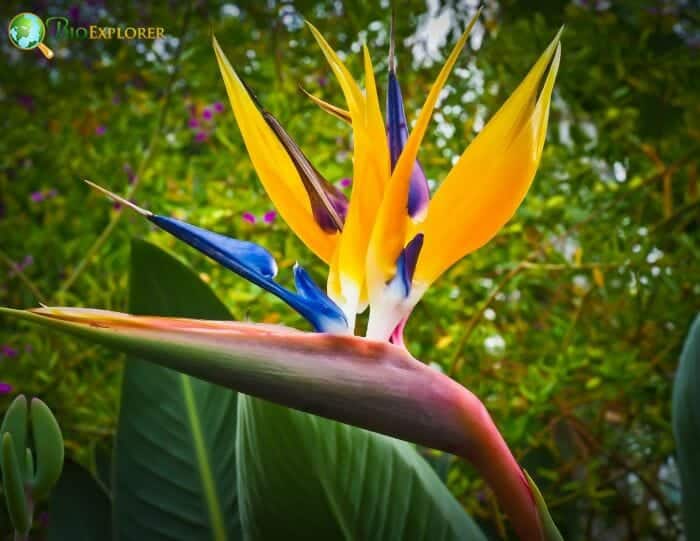
Species under Zingiberales are very beneficial. Some members are used as ornamentals, folk medicine, food, and food spices. The following are plants under the order Zingiberales:
- Shell Ginger[12] – The species is grown as a houseplant or patio plant.
- Red Ginger[13] – The species is commonly planted for ornamental purposes.
- Wild Banana[14] – The fruit is edible.
- Cavandish Banana – The fruit is edible.
- Bird of Paradise[15] – The plant is of ornamental value.
- Traveler’s Tree[16] – The plant has many beneficial uses. The seed and the fruit (raw) are edible. The seed oil is sometimes used in cooking. The leaves are consumed for roofing and packing material purposes. Traveler’s tree also possesses medicinal uses.
- Lobak Hutan[17] – This plant has ornamental foliage and flowers desirable for landscaping.
- Toucan Beak – The plant has ornamental value; ideal for outdoor planting.
- Orange Tulip Ginger[18] – The plant has ornamental flowers. It is commonly used for landscaping.
- African Arrowroot – The tubers of this species are edible.
![]()











